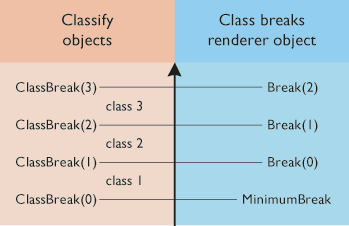The array of class breaks (double). ClassBreaks(0) is the minimum value in the dataset, and subsequent breaks represent the upper limit of each class.
[Visual Basic .NET] Public ReadOnly Property ClassBreaks As Object
[C#] public object ClassBreaks {get;}
[C++]
HRESULT get_ClassBreaks(
VARIANT* doubleArrayBreaks
);
[C++]Parameters
doubleArrayBreaks [out, retval] doubleArrayBreaks is a parameter of type VARIANT
Product Availability
Available with ArcGIS Engine, ArcGIS Desktop, and ArcGIS Server.
Description
ClassBreaks returns an array of class breaks. The number of breaks may be different than what was specified in the Classify method, so it is essential that you check this before setting the BreakCount on IClassBreaksRenderer . The reason this may be different has to do with how a particular classification method handles skewness in the data being classified.
The first ClassBreak returned is the minimum value of the data being classified. The rest of the breaks are the upper bounds for each class. The last break represents the upper bound of the highest class.
To properly assign ClassBreaks to an IClassBreaksRenderer:
1. Set IClassBreaksRenderer.MinimumBreak = IClassify.ClassBreaks(0)
2. Set IClassBreaksRenderer.Breaks(0) = IClassify.ClassBreaks(1)
3. Set IClassBreaksRenderer.Breaks(1) = IClassify.ClassBreaks(2)
etc.
Remarks
Note that the Breaks property array on the ClassBreaksRenderer has one less entry than the array returned from Classify. The first break value in the array returned from Classify is put into the ClassBreakRenderers’ MinimumBreak property. Next, copy the break values into the ClassBreaksRenderer object. You can set up the symbol property of the classes at the same time.
